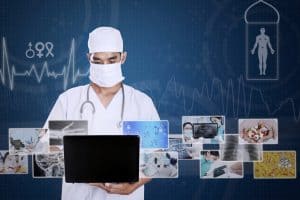
Continuous intelligence (CI) is enabling innovative approaches to healthcare, giving clinicians fast, more accurate diagnosis capabilities.
Healthcare organizations are blessed with a wealth of data to evaluate patient conditions and prescribe a treatment plan. Increasingly, the ability to make faster, more accurate diagnoses requires continuous intelligence (CI) derived from the real-time analysis of streaming data.
Two factors are driving this change. First, patient expectations are changing. The quality of care is increasingly important – as patients begin to exercise their right to choose how and with whom they engage for their healthcare. They demand transparency of data and processes. Consequently, healthcare organizations need to focus on how quality outcomes can be achieved in a meaningful way for patients.
See also: AI Providing Mental Health Guidance? Not So Fast, Say Psychiatrists
At the same time, healthcare is experiencing great changes by virtue of the availability of new data sources. Specifically, there is the rise of the internet of things (IoT) wearables and connected medical devices. As healthcare organizations use more connected devices, electronic health records (EHRs), and virtual visits with patients, more and more data is pouring in.
However, that data typically sits siloed and does not improve patient care until it’s been reviewed and filed away for use in the future. Making strides requires solutions that can easily make use of the different data sources and apply real-time analytics to that data on the fly.
Real-time Data for Diagnosis
Solutions that overcome the data obstacles open up new opportunities. For example, using streaming data can help in early diagnosis of a variety of health conditions is many areas. One example is the application of voice communications to diagnose medical conditions.
Consider the following scenario: A woman calls in concerned about her mother’s health as she has recently been having issues with memory loss. The mother calls into her clinic’s nurse triage line, where her nurse asks five questions to gather information for diagnosis. Sentiment analysis is run on the voice communication with the nurse. The information derived from that analysis is combined with the health data captured from the mother’s wearable device (that the nurse can view in real-time). The nurse then uses the information to determine Alzheimer’s disease is within a high degree of probability. As a result, this interaction helps the daughter determine next steps for her mother’s health care.
With a plethora of connected devices available today, something as simple as voice communications being used to diagnose (or determine the probability of diagnosis) is the ultimate medical bot.
Using analytics in voice communications for the early diagnosis of certain medical conditions is close to today’s reality. For instance, the Apple Watch now comes with an Electrocardiogram (EKG) feature — providing users with information about their heartbeat that can help alert them to undiagnosed conditions. The real-time data provided by wearables like the Apple Watch can serve as a first step in diagnosing certain health conditions and alerting patients to consult with their provider when data signifies that something is amiss.
Combining Real-time Analytics with AI
Using real-time analytics to diagnose conditions is pushing medical treatment to new levels. Even more advanced are applications that use predictive analytics and artificial intelligence (AI) to prevent the outbreak of a disease or condition.
One example of the application of this preventive technology is the work being done by HCA Healthcare in reducing the threat of death by sepsis.
Sepsis is an unforgiving condition that can wreak havoc on the body. It often creeps up, like a thief in the night, after people are already admitted to hospitals to treat other conditions. It erupts as the body is fighting infection, triggered by an imbalance in the very biochemicals the body is sending out into the bloodstream to fight infection. If sepsis progresses to septic shock, organs are damaged, and blood pressure drops – a potentially deadly situation. Sepsis is responsible for 270,000 deaths per year in the United States alone.
Typically, diagnosing sepsis is only possible based on manual review of patient charts during shift changes. The problem is by the time sepsis is detected this way, it may be too late. “Every hour of delayed diagnosis increases the risk of death by four to seven percent,” says Dr. Jonathan Perlin, president for clinical services and chief medical officer for healthcare at HCA Healthcare.
This delay was not acceptable. A team of clinicians, data scientists, and technology professionals banded together to create a real-time predictive analytics system to more accurately and rapidly detect sepsis in patients.
The challenge was capturing the data related to pre-sepsis conditions. There was plenty of it generated by the healthcare company’s more than 30 million annual patient interactions each year across 1,800 care sites. However, much of it was siloed across disparate systems and applications.
Most existing data infrastructures were not designed for large-scale business intelligence and reporting. What’s needed is a way to gather, analyze, and share real-time data from all of our facilities so that life-saving action can be taken quickly. To address this challenge, the team created a real-time predictive analytics system called SPOT (Sepsis Prediction and Optimization of Therapy).
With SPOT, clinicians can more accurately and rapidly detect sepsis in patients. The platform collects and analyzes clinical data — such as patient location, vital signs, pharmacy, and laboratory data — and signals caregivers in real-time to initiate early sepsis care.
With the SPOT tool, HCA Healthcare is able to improve early detection. Clinicians can detect and identify initial indicators of sepsis up to 20 hours earlier than traditional screening methods.
Analytics’ Role in Early Detection of Medical Fraud
Beyond diagnosis, real-time analytics is being eyed for other healthcare applications. For example, one of the major issues in the healthcare industry today is the amount of medical fraud that occurs. In 2017, there were $1.3 billion in false billings, according to the Office of Inspector General of the U.S. Department of Health & Human Services. Analytics can play a significant role in detecting medical fraud as well as aiding in the early diagnosis of medical conditions.
Imagine a medical call center using voice analytics technology during a call from a patient who is attempting medical fraud. With analytics embedded in the software, red flags in the patient’s tone of voice could be pinpointed. The person handling the call could then be alerted to the concern signified through the analytics, allowing them to investigate the situation at a deeper level. Analytics could one day play a key role in the early detection of medical fraud – alerting organizations to potential fraud as early as the appointment scheduling process.
The Real Challenge: Work with Data
In all efforts, the main challenge is how to use the large number of data sources efficiently. A suitable solution will be able to:
Fusing different data sources continuously: Medical devices provide visual displays of vital signs through physiological streams such as an electrocardiogram (ECG), heart rate, blood oxygen saturation (SpO2), and respiratory rate. Electronic health record initiatives around the world create more sources of medical data. Life-threatening conditions such as nosocomial infection, pneumothorax, intraventricular hemorrhage, and periventricular leukomalacia can be detected using analytics that fuses different data sources.
Deliver highly personalized care: Detect signs earlier to improve patient outcomes and reduce the length of stays. Automated or clinician-driven knowledge discovery to identify new relationships between data stream events and medical conditions.
Support proactive treatment: Build a profile for each patient based on personalized data streams and receive insights continuously
Conclusion
Simply put, the real-time potential for analytics to alleviate a variety of challenges in the healthcare industry today is enormous. With all the headway that has been made in the creation of new technology to catapult healthcare into the next generation of patient experience, it is only natural that the deployment of real-time analytics for early medical diagnosis, medical fraud, and other applications will follow.







